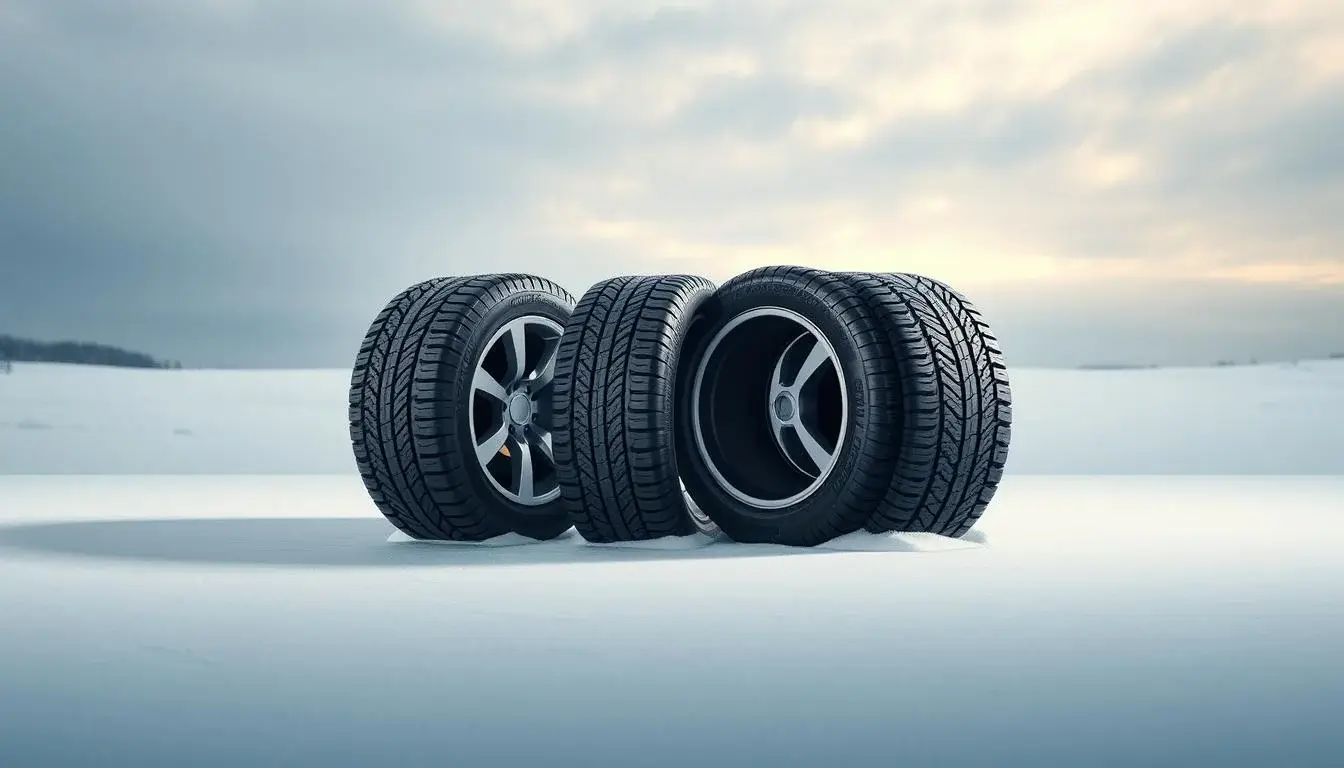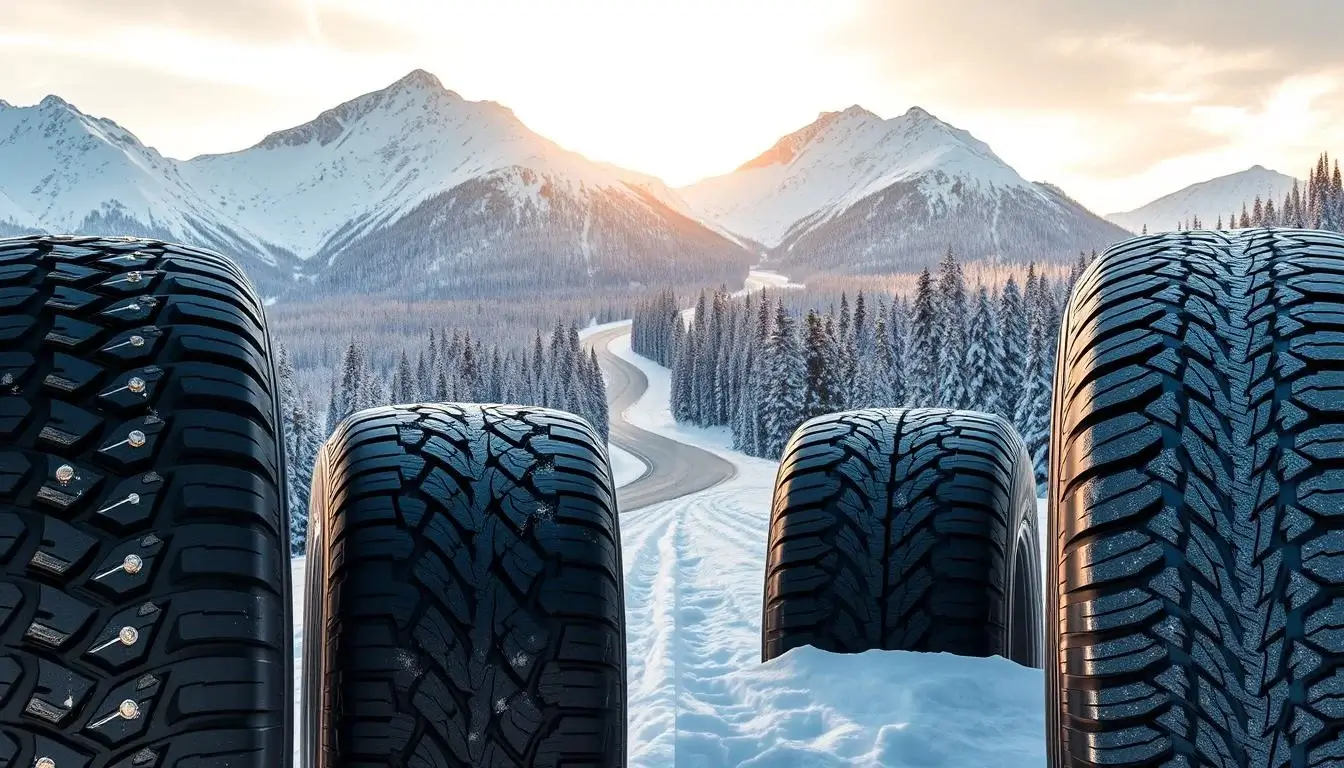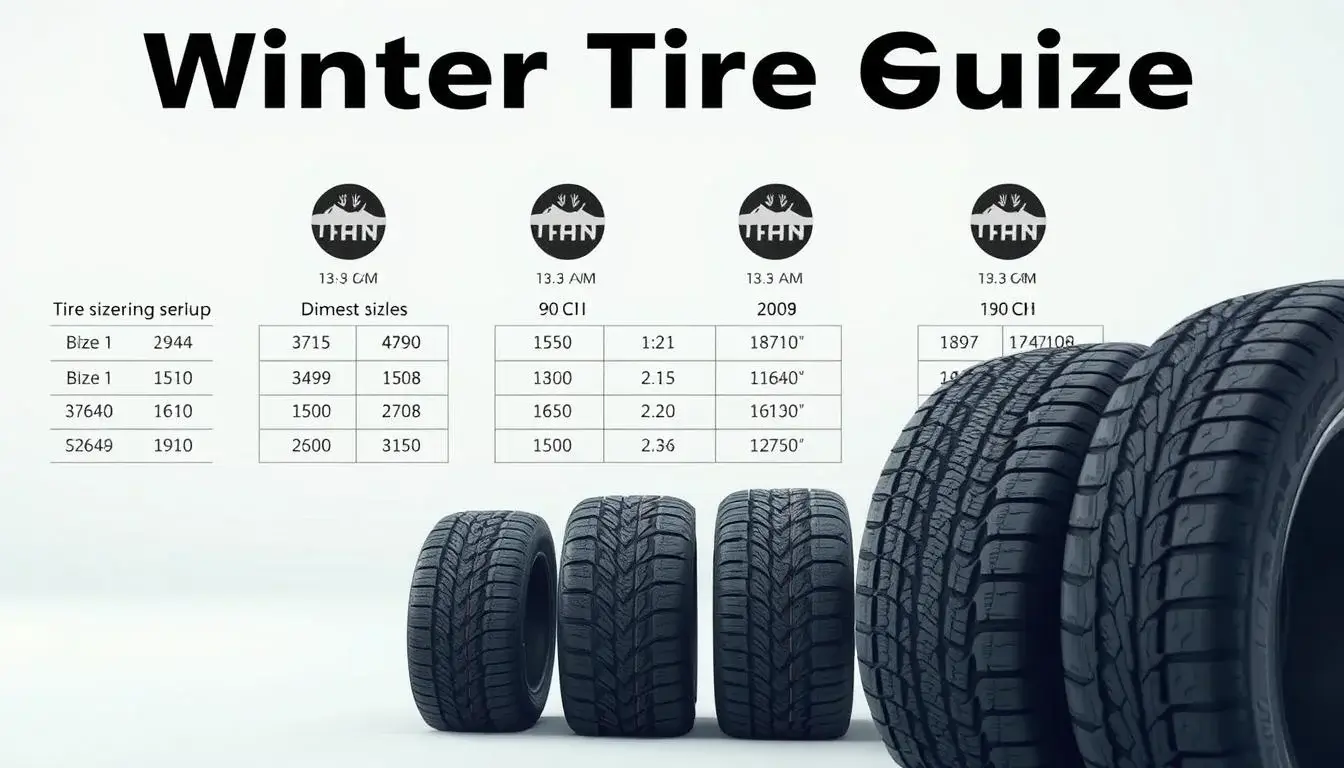Are you ready to conquer winter roads with confidence? As the chill sets in and snow blankets the streets, your choice of winter tires can make all the difference. Let’s explore the top winter tire options for 2025 that’ll keep you safe and rolling through the frostiest conditions.
Winter driving demands more than just all-season tires. The best winter tires are engineered with specialized tread patterns and rubber compounds. They tackle snow, ice, and frigid temperatures. These tires provide superior traction and handling when the mercury drops, ensuring your vehicle stays firmly planted on slippery surfaces.
From bustling city streets to winding mountain roads, the right winter tire can transform your driving experience. Whether you’re piloting a nimble sedan or a rugged SUV, we’ve got you covered. We offer top-rated options that blend cutting-edge technology with tried-and-true performance.
In this guide, we’ll dive into the latest innovations in winter tire technology. We’ll compare studded and studless options, and provide expert tips on choosing the perfect set for your vehicle. Get ready to embrace winter with renewed confidence and safety on the road.
Key Takeaways
- Winter tires are critical for safe driving in cold and snowy conditions
- Specialized tread patterns enhance traction on icy and snowy roads
- Advanced rubber compounds maintain flexibility in freezing temperatures
- Proper winter tire selection varies based on vehicle type and driving needs
- Regular maintenance and timely installation are key to optimal winter tire performance
Understanding Winter Tire Technology and Innovation
Winter tires are made to handle tough winter weather. They have advanced tech for better ice grip and safety on snowy roads. Let’s look at the key innovations that make winter tires special.
Specialized Rubber Compounds for Cold Weather
The rubber in winter tires stays flexible in cold. This helps the tire grip the road better, even on icy or snowy surfaces. Brands like Bridgestone Blizzak and Michelin X-Ice use special rubber that stays flexible even below freezing.
Three-Peak Mountain Snowflake Certification
When buying winter tires, look for the Three-Peak Mountain Snowflake symbol. This symbol means the tire has passed tough snow traction tests. It’s your guarantee that the tire will work well in harsh winter weather.
Advanced Tread Patterns and Siping Technology
The tread pattern on winter tires is made to dig into snow and push away slush. Studless winter tires have tiny slits called sipes. These sipes create many biting edges that help grip ice and packed snow, making your car more stable and easier to stop.
| Feature | Purpose | Benefit |
|---|---|---|
| Flexible Rubber Compound | Maintain grip in cold | Better traction on icy roads |
| Three-Peak Mountain Snowflake | Certify winter performance | Assurance of quality in severe weather |
| Advanced Tread Pattern | Channel snow and slush | Improved stability and control |
| Siping Technology | Create biting edges | Enhanced grip on ice and packed snow |
🚗 Ready to upgrade your tires for this winter?
If you’ve found the right winter tire in our top picks, don’t wait to prepare your vehicle for the cold months ahead. Amazon not only offers competitive prices but also helps with tire installation in your area through their trusted network of service providers.
🔗 Shop Winter Tires and Schedule Installation on Amazon Now
Best Winter Tires for Different Vehicle Types
Choosing the right winter tires is key for safety and performance in cold months. Let’s look at top picks for various vehicles to help you choose wisely.
Premium Sedan and Passenger Car Options
For sedans and passenger cars, the best winter tires balance traction and comfort. They can stop up to 30% faster on snowy roads than all-season tires. The Michelin X-Ice Xi3 and Bridgestone Blizzak WS90 are favorites for their ice grip and quiet ride.
SUV and Crossover Winter Tire Selection
SUVs and crossovers need winter tires that handle their weight and offer stability. The Continental VikingContact 7 and Nokian Hakkapeliitta R3 SUV are top choices. They improve handling by about 25% on ice, perfect for larger vehicles.
Heavy-Duty Truck and Commercial Vehicle Tires
Trucks and commercial vehicles need durable tires with great traction. The Goodyear Ultra Grip Ice WRT and Cooper Discoverer Snow Claw are top picks. They handle heavy loads well and perform great in snow and ice. About 80% of commercial fleets use these tires for safety and efficiency.
| Vehicle Type | Recommended Tire | Key Feature |
|---|---|---|
| Sedan | Michelin X-Ice Xi3 | Exceptional ice grip |
| SUV | Continental VikingContact 7 | 25% improved handling on ice |
| Truck | Goodyear Ultra Grip Ice WRT | Excellent heavy load handling |
Remember, the best snow tires for cars depend on your vehicle and driving conditions. Always talk to a tire expert to find the perfect fit for you.
Top-Rated Studded vs Studless Winter Tires
Choosing between studded and studless winter tires is key for safe winter driving. Studded tires, like the Nokian Hakkapeliitta 10, grip icy roads better. They were introduced in 2020, improving grip, comfort, and reducing noise.
Studless winter tires, such as the Bridgestone Blizzak WS90, perform well without studs. The Blizzak WS90 uses EdgePerformance Technology for lasting traction.
| Tire Type | Best Winter Tires Studded | Studless Winter |
|---|---|---|
| Top Pick | Nokian Hakkapeliitta 10 | Bridgestone Blizzak WS90 |
| Traction | Excellent on ice and packed snow | Very good on snow and slush |
| Noise Level | Higher (similar to gravel) | Lower |
| Fuel Economy | 2-3% decrease | Minimal impact |
| Legal Restrictions | May be restricted in some areas | No restrictions |
Deciding between studded and studless tires depends on your local driving conditions and laws. Studded tires are best for icy and harsh winters. For milder climates, studless tires like the Continental VikingContact 7 or Michelin X-Ice Snow SUV are great. They offer good performance without the noise and road damage studs can cause.
Performance Features and Safety Considerations
Winter tires are key to staying safe on icy and snowy roads. They have special features that make them vital for winter driving.
Ice and Snow Traction Capabilities
Winter tires grip snow and ice better than others. Their rubber stays flexible in cold, giving you better control on slippery roads. This is important for driving on snow or ice.
Braking Distance on Winter Roads
Winter tires are great at cutting down on braking distance on snowy and icy roads. They stop shorter than all-season tires, which is key for staying safe in slippery conditions.
| Tire Type | Braking Distance on Snow (ft) | Braking Distance on Ice (ft) |
|---|---|---|
| Winter Tires | 80 | 120 |
| All-Season Tires | 120 | 180 |
Handling in Extreme Weather Conditions
Winter tires handle slushy and icy roads better. Their tread patterns push snow, slush, and water away, keeping you in contact with the road. This helps keep your vehicle stable and in control in tough winter weather.
“Winter tires are not just for snow. They provide superior performance on cold, wet pavement and icy roads, making them essential for overall winter safety.”
Winter Tire Buying Guide and Price Analysis
Choosing the right winter tires can be tough. This guide will help you make a smart choice for the cold months.
Size Selection and Compatibility
It’s important to find the right size for your car. Check your car’s manual or the driver’s side door jamb for tire size. Winter tires might be different from your all-season tires.
Cost-Benefit Analysis
Quality winter tires are worth the investment. They improve safety and performance. Here are some popular options:
| Tire Model | Price Range (per tire) | Mileage Warranty |
|---|---|---|
| Falken Wildpeak A/T3W | $210 | 55,000 miles |
| Yokohama Geolandar A/T4 G018 | $167 – $490 | 65,000 miles |
| Goodyear Wrangler TrailRunner | $118 | 55,000 miles |
Installation and Maintenance Tips
Get your tires mounted by experts for best results. Rotate them every 5,000 miles for even wear. Store them right during off-seasons to last longer.
Consider a tire test before buying. This guide will help you pick the best winter tires. You’ll stay safe and perform well in the cold.
❄️ Don’t Wait – Get Your Winter Tires and Installation Sorted Today!
Winter is just around the corner, and having the right tires is essential for staying safe on icy and snowy roads. With Amazon, you can quickly compare options, read reviews, and even schedule professional installation services in your area for a hassle-free experience.
🚙 Be winter-ready and make your purchase today!
🔗 Find Your Perfect Winter Tires and Installation on Amazon
Conclusion
Choosing the best winter tires is key for your safety on icy roads. Modern winter tires have special rubber for better grip in cold. They help you stay safe on snowy streets and avoid black ice.
Think about your car’s needs and your area’s weather when getting ready for winter. Choose tires that are great for ice and snow. Good winter tires mean safer driving, better control, and less worry during cold months.
Don’t wait for the first snow to get your winter tires. Get them ready before it gets cold. This way, you’ll have the best grip and control when it matters most. Stay safe this winter with tires that handle freezing and slippery roads well.
🚗 Curious about whether winter tires are worth it?
Learn how they improve safety and performance in our complete guide:
🔗 Do Winter Tires Make a Difference? How to Choose the Best Ones?
FAQ
When should I switch to winter tires?
Switch to a set of winter tires when temperatures drop below 45°F (7°C), typically in late fall or early winter months. Winter tires are designed to provide traction in freezing temperatures, offering better performance in winter driving conditions, even during occasional snow and ice.
Are winter tires better than all-weather tires?
Yes, while all-weather tires perform well in a variety of conditions, they cannot match the performance of winter tires in extreme winter conditions. Winter tires feature a special winter tread compound that remains flexible in cold temperatures, improving grip in the snow and icy conditions.
What’s the difference between studded and studless winter tires?
- Studded winter tires: Equipped with metal studs for improved ice traction and better grip on slick ice found during the worst winter conditions. However, they can damage roads and are restricted in some areas.
- Studless winter tires: Use silica-infused tread compounds and unique tread patterns with circumferential and lateral grooves to channel slush away and maintain control. They’re quieter and legal everywhere.
Which winter tires are best for extreme winter conditions?
For extreme winter conditions, models like the Bridgestone Blizzak DM-V2 or the Dunlop Winter Maxx are excellent choices. These tires offer aggressive tread patterns and superior braking performance on deep snow and ice. For light trucks, the Pirelli Sottozero 3 provides a great balance of durability and performance.
How long do winter tires typically last?
With proper care, winter tires offer longevity for 30,000 to 40,000 miles, or about 3-4 winter months of seasonal use for several years. Regularly check tread depth to ensure safety, as deeper treads improve traction in freezing temperatures and channel slush away effectively.
Can I use winter tires year-round?
No, winter tires are designed for winter driving conditions and wear out faster in dry and wet conditions during warmer months. Their tread compound is optimized for cold temperatures, making them unsuitable for year-round use. Switch to all-weather tires or summer tires during the rest of the year.
What does the Three-Peak Mountain Snowflake (3PMSF) symbol mean on a tire?
The 3PMSF symbol indicates that the tire meets standards for severe winter conditions. While all winter tires feature this mark, not all all-weather tires with the symbol perform as well in extreme winter conditions like special winter tires.
How do I choose the right size winter tires for my vehicle?
Choosing the best size for your vehicle involves checking the specifications in your owner’s manual or on the driver’s side door jamb. Ensure the tire’s size matches your vehicle’s needs for optimal performance. For advice, consult a professional or trusted retailer like Tire Rack.
Are more expensive winter tires worth the investment?
Premium brands like Bridgestone Blizzak, Pirelli Sottozero, and Dunlop Winter Maxx often include advanced features like silica-infused compounds, aggressive tread patterns, and superior performance in a variety of conditions. While more expensive, these tires provide the best possible safety and performance in winter months, making them worth the investment for challenging climates.
Can winter tires handle deep snow and slush?
Yes, winter tires are designed with unique tread patterns and deep snow grooves to improve grip and channel slush away from the contact patch, ensuring better stability and safety in heavy snow.
How should I store my winter tires during the off-season?
Store your winter tires in a cool, dry place, away from the contact patch with direct sunlight or heat sources. Use tire bags or racks to maintain their condition, and check the tire’s pressure before reinstalling for the next season.


